SERIES ANALYSIS: 1804 and other Famous Early Silver Dollars Sell in Miller, Part II Auction
The author performs a further analysis of the silver dollar rarities in the Larry H. Miller Collection that was auctioned on December 17 by Stack's Bowers.
The second part of the Larry H. Miller Collection was auctioned on December 17 by Stack’s-Bowers at The Balboa Bay Resort in Newport Beach, California. The purpose here is to focus on early silver dollars that were the stars of the Miller II sale. Another review in an upcoming issue of the CPG® Coin & Currency Review will be about some of the really neat, though relatively inexpensive coins from the Larry Miller Collection in this same auction.
While coverage of coin auctions should not only be about expensive rarities and condition rarities, the Miller II sale had so many famous rarities, which had been ‘off the market’ for more than a dozen years, it is imperative that at least a couple of these be discussed publicly. Indeed, the Stickney-Eliasberg-Miller 1804 silver dollar is one of the most famous of all American coins.

STICKNEY-ELIASBERG-MILLER 1804 SILVER DOLLAR
The $3,360,000 result for the Stickney-Eliasberg-Miller 1804 is a moderate to strong price, above wholesale though not well into the pertinent retail range. This was a fair to good deal for the buyer in the current market environment, though market levels for rarities during 2021 may be quite different. Like the Dexter-Dunham-Pogue 1804 dollar that Stack’s-Bowers auctioned in March 2017 for $3,290,000, the Stickney-Eliasberg-Miller 1804 is PCGS certified as Proof-65. In my opinion, the Eliasberg-Miller 1804 is of higher quality and is the third finest, privately owned 1804 dollar.
Larry Miller was fortunate to own both the Eliasberg 1804 silver dollar and the Eliasberg 1894-S dime, two of the three most famous rarities from the most famous coin collection of all time. In my roster of 1894-S dimes that was published online in July 2013, I demonstrated that only nine 1894-S dimes are currently known. Almost every other researcher had said that there were eleven or twelve! As far as I know, I was then the only researcher who insisted that just nine are known.
Also, I then provided information regarding owners and pertinent private transactions over the last thirty years. Admittedly, however, that roster needs to be revised. Additional auction results, observations and opinions need to be incorporated into the roster. Curiously, the Eliasberg-Miller 1894-S dime has naturally toned since its last public appearance and is more attractive in the present than it was before. Silver dollars, though, are the topic of the moment, as a majority of the famous coins in the Miller Collection were silver dollars.
The Stickney-Eliasberg-Miller 1804 is a Class I 1804 dollar, which means that it was minted in 1834 or 1835 rather than in 1858 or later. No surviving 1804 dollars were minted in 1804. No one now knows for certain as to why the specially made coins that collectors now know as “1804 dollars” were dated 1804.
Besides the silver dollars and eagles ($10 gold coins), all the coins in each of the diplomatic Proof or Special sets of 1834-35 were dated 1834, including a half cent, a large cent, silver denominations, a quarter eagle, and a half eagle. As a fully intact diplomatic Proof set does not survive, the precise contents of each such set remain a mystery. These sets were intended to be given to monarchs in Asia, and at least two were delivered. I discuss 1804 dollars in the January 2020 issue of the CDN Monthly Greysheet (Vol. III: No. 1, pp. 13-14).
The legend of 1804 dollars developed and grew long before much was widely known by collectors about the circumstances at the Philadelphia Mint during the 1830s. This same 1804 dollar commanded attention when the firm of Henry Chapman auctioned the collection of Matthew Stickney in June 1907. This 1804 dollar then realized $3,600, a record price for an 1804 dollar though much less than the price realized, $6,200, by the Brasher Doubloon in the same auction in 1907.
On April 8, 1997, a general auction record was set when the Stickney-Eliasberg 1804 realized $1,815,000 in the Eliasberg ’97 sale in New York by Bowers & Merena of New Hampshire. The previous auction record for any coin was established less than one year earlier in the Eliasberg ’96 sale. Jay Parrino paid $1,485,000 for the Eliasberg Collection 1913 Liberty Head nickel on May 21, 1996, which then became the first coin to sell at auction for more than $1 million.
That $1,485,000 result on May 21, 1996, was exactly 50% higher than the price realized for the Dexter-Dunham 1804 dollar, $990,000, in the Rarcoa session of Auction ’89, a coin auction festival during the summer of 1989. The same Dexter-Dunham 1804 silver dollar was later in the Pogue Family Collection and was auctioned for $3.29 million by Stack’s-Bowers in the Pogue V sale on March 31, 2017. In April or May 2017, John Albanese sold the Dexter-Dunham 1804 to Bruce Morelan.
As for the record-setting Eliasberg 1913 Liberty Head nickel, Stack’s-Bowers auctioned it for $4,560,000 on August 15, 2018, more than three times as much as the same coin realized on May 21, 1996. It is curious that the Stickney-Eliasberg 1804 dollar did not even realize twice as much in December 2020 as it did in April 1997, $3,360,000 versus $1,815,000.
The Stickney-Eliasberg-Miller 1804 dollar and the Eliasberg 1913 Liberty Head nickel are similar in that rarity, fame and pedigrees define the coins much more so than their physical characteristics. These are not among the most attractive of all U.S. coins, nor the most original.
The Stickney-Eliasberg-Miller 1804 was moderately to heavily cleaned very long ago and has since naturally retoned in a nice way. In actuality, the colors on this coin are more attractive than they appear to be in published images. There are shades of gray on much of the coin, but there are other colors, too. When the Stickney-Eliasberg-Miller 1804 is tilted at various angles, different hues and shades become evident. At some angles, the obverse is a brown, green and gray mixture with much green in the outer fields. The reverse is mostly a rich brown-russet with some blue tinted areas and appealing green peripheral toning.
Miss Liberty is a light gray, though parts of her hair naturally glisten. There is evidence that this coin was at least semi-cameo, perhaps fully cameo, when it was struck. Moreover, the toning is probably stable. The Eliasberg-Stickney-Miller 1804 dollar is a pleasant Great Rarity.
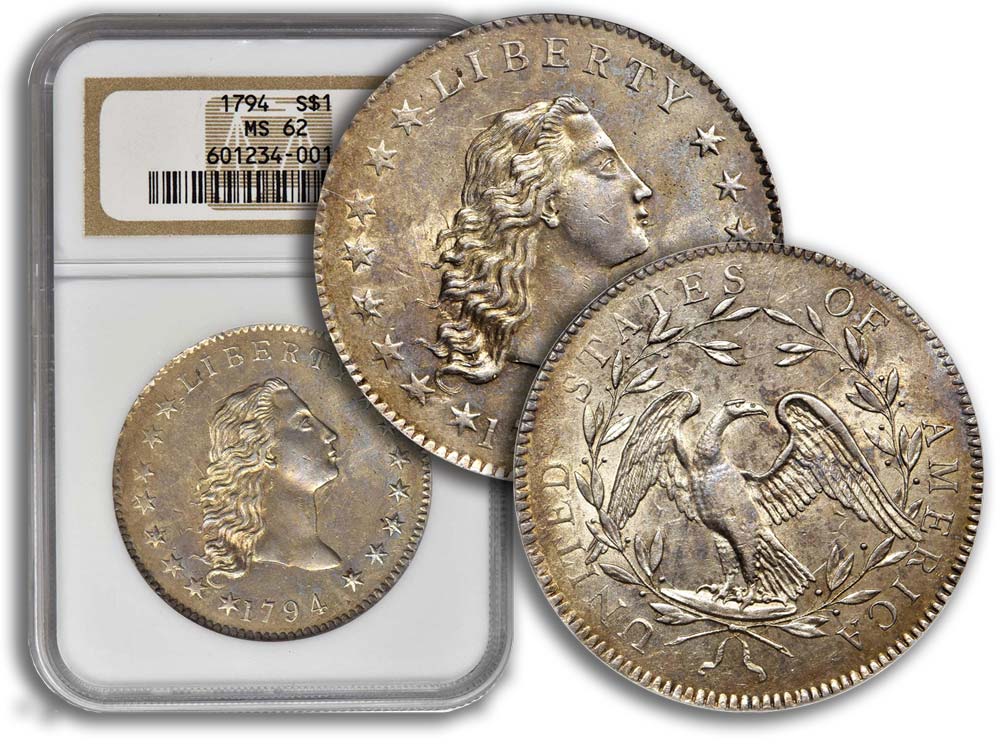
THE LARRY H. MILLER 1794 SILVER DOLLAR
The sale of the Miller 1794 dollar for $1,050,000 is newsworthy. Back in March 2017, Stack’s-Bowers auctioned the PCGS graded AU58+ Blue Moon Collection 1794 for $910,625. The Blue Moon 1794 was CAC approved as AU58, as experts at CAC ignore the plus aspect of a plus grade assigned by PCGS or NGC. The Miller 1794 has much less friction than the Blue Moon 1794. The $910,625 result for the Blue Moon 1794 was aggressive in March 2017 and not a good value then. Market levels have since decreased to a mild extent.
Although friction on highpoints is very clearly apparent, the Miller 1794 does and should have the value of a MS61 grade coin in my view, as its positive characteristics tend to pull the Miller 1794 away from 1794 dollars in the range of circulated grades. The tan-gray-brown blend is probably natural retoning after a dipping many decades ago. There are no distracting imperfections. The Miller 1794 is a particularly attractive coin overall.
I find the Miller 1794 to be superior to the just mentioned PCGS graded AU58+ Blue Moon 1794. The $1,050,000 result for the Miller 1794 was a strong price, fair retail.
I would like to see the Harry Bass 1794 dollar again before compiling a roster. While the color of the Connecticut Historical Society-Hesselgesser 1794 dollar is relatively more original and much more appealing, that coin has more friction and more mint-caused imperfections than the Miller 1794. In my view the Miller 1794 is superior overall to the Connecticut-Hesselgesser 1794 dollar, which has been certified as AU58 by PCGS, NGC and CAC.
The Miller 1794 is tentatively ranked as #7 or #8. Given the mania for 1794 dollars that began around 2012, any 1794 dollar in the top ten has become a very famous and valuable coin.
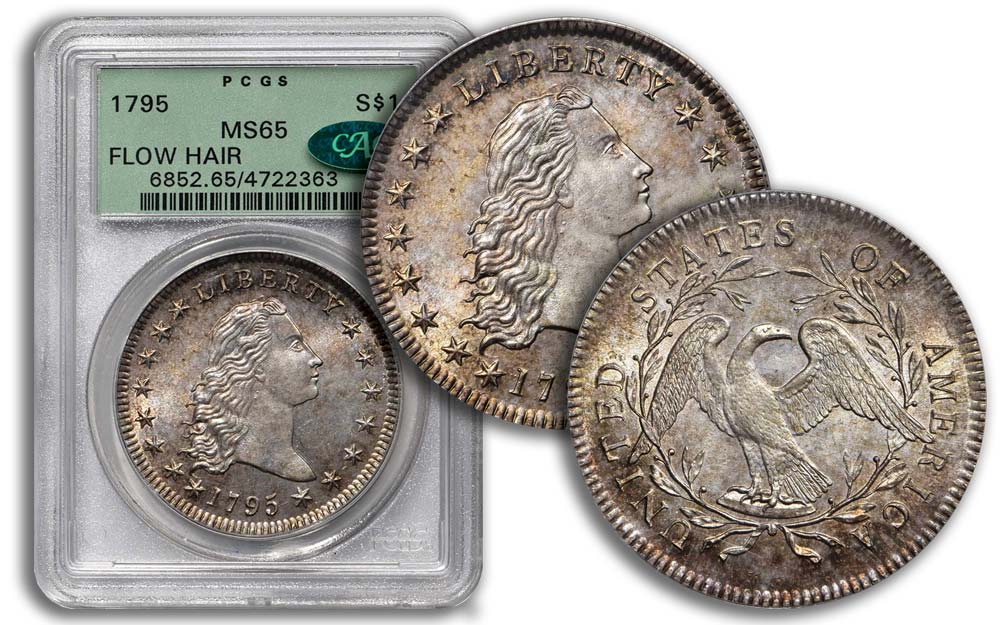
GEM 1795 TWO LEAVES DOLLAR
One of the strongest prices in the whole auction was the $576,000 result for a CAC approved, PCGS graded MS65 1795 Two Leaves silver dollar. The number of leaves directly below each of the eagle’s wings defines the two major varieties of 1795 Flowing Hair silver dollars.
I disclose here a conflict of interest as I was asked by a client for a report about this coin prior to the auction. Before the auction, I said that this coin should be worth a price commensurate with a grade in low to mid MS65 range, though it could very well bring a higher amount in the auction. I asserted then that I would not be startled if two serious bidders each grade the coin as MS65+ or 66. While I understand such an interpretation of this coin, I regard it as a gem but not as a superb gem.
Before the auction, the Greysheet Bid value for a MS65 CAC Flowing Hair dollar was $350,000 and the CPG®-CAC retail price estimate was $420,000. The Greysheet (non-CAC) Bid is or was $300,000. During the 2011 to mid-2015 bull market, the Greysheet Bid for a MS65 Flowing Hair dollar reached $350,000 or higher. In March 2008, however, when market levels for classic U.S. coins overall were nearing peak levels that have not been matched during the last dozen years, Greysheet Bid for a MS65 Flowing Hair 1795 dollar was $285,000. The puzzle now is why this specific 1795 Flowing Hair dollar brought so much, $576,000 on December 17, 2020.
I had figured that $340,000 would have been a weak price. A moderate price, around the wholesale-retail border, would have been in the range of $380,000, I estimated. A mid-retail price would have been $425,000, a number that is nearly the same as the CPG®-CAC retail value estimate. In my view before the auction, a high-retail price would have been $465,000.
As for why this coin brought $576,000, three explanations come to mind:
CAC preference: one or two bidders may have demanded a CAC approved MS65 Flowing Hair dollar now! This coin is the only gem 1795 Flowing Hair Two Leaves dollar to have a CAC sticker. Among Flowing Hair Three Leaves 1795 dollars, CAC has approved one as MS65 and one as MS66, plus one with a silver plug as MS65. The Pogue-Simpson 1795 Flowing Hair Three Leaves dollar with a silver plug just sold for $630,000 on September 17 in the Simpson I sale by Heritage. This coin was CAC approved at the MS65 level and PCGS graded MS65+. The Pogue-Simpson, Three Leaves 1795 Flowing Hair dollar, with a silver plug, will not be available again for a long time. The current market reality is that the silver plug substantially increases the value of a 1795 Flowing Hair dollar, especially since those with a silver plug are now listed separately in major guides. When will the next CAC approved MS65 to MS66 grade 1795 Flowing Hair dollar, of any variety, be available? Someone who is building a CAC-only date or type set may have felt compelled to bid aggressively on this Miller Collection coin.
Collecting both: my second theory is that at least one serious bidder was demanding both 1795 Flowing Hair Three Leaves and Two Leaves silver dollars that grade MS65 or higher and are satisfactory to the respective buyer. It would be difficult to obtain 1795 Two Leaves and 1795 Three Leaves dollars that most experts would regard as being of gem quality or nearly so. This Miller Collection coin is superior to the two PCGS graded MS65 1795 Two Leaves dollars that were in the Pogue Family Collection. On September 30, 2105, these two Pogue coins realized $282,000 and $258,500, respectively. Market levels were higher in September 2015 than they were in December 2020. The difference in quality between the Miller Two Leaves dollar and the Pogue Two Leaves dollars may be a prime determinant of the price realized on December 17, 2020, especially if a gem Two Leaves 1795 dollar was being sought.
Upgrade potential: a third theory is that a grading wholesaler could have figured that the probability of this coin upgrading at PCGS was such that it made mathematical sense to pay more than $550,000 for it. They could have factored bids while analyzing probabilities and associated expected values of this coin being upgraded to MS66 by PCGS or at least to MS65+. I hope this third theory is not true.
The most interesting aspect of theorizing about this auction result is the possibility that a Two Leaves 1795 may in theory be worth much more than an equivalent 1795 Flowing Hair Three Leaves dollar. Although the Two Leaves variety is scarcer in mint state grades, most collectors of choice to gem uncirculated silver dollars in the past sought just one or the other and did not feel a need to obtain representatives of both major varieties in choice to gem grades. Also, collectors assembling type sets are usually not concerned about the number of leaves on the reverse of a 1795 dollar.
A puzzling price realized should not deflect attention from the fact that this is an excellent coin and a very important condition rarity. The reverse of the Miller Collection, 1795 Flowing Hair Two Leaves Dollar is technically amazing. Overall, it is very attractive. I hope that the new owner is a collector who understands and cherishes this coin.
In regard to the quality of rare coins, there will always be legitimate differences of opinion among experts, though most pertinent experts will not publicly and honestly reveal their respective opinions. I suggest that collectors seek to learn about coins and ask penetrating questions. While price guides and knowledgeable consultants are useful, a collector of expensive coins should think carefully about how much each individual rare coin is worth to him or her.
Copyright ©2021 Greg Reynolds
Insightful10@gmail.com
Images courtesy of Stack’s Bowers Galleries.

Download the Greysheet app for access to pricing, news, events and your subscriptions.
Subscribe Now.

Subscribe to The Greysheet for the industry's most respected pricing and to read more articles just like this.
Source: Greg Reynolds
Related Stories (powered by Greysheet News)
View all news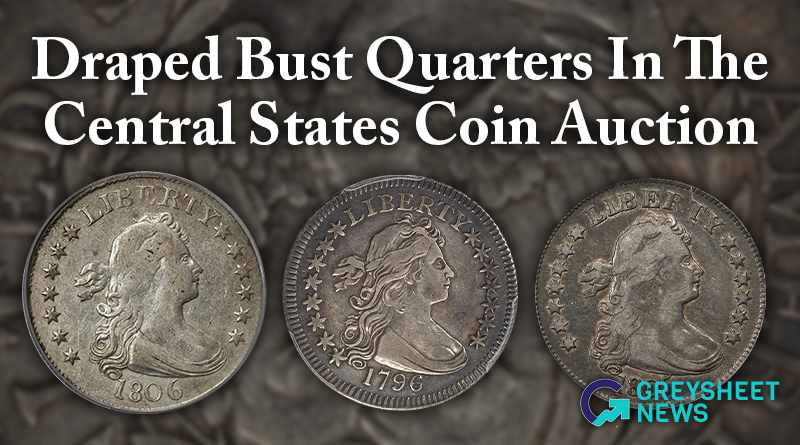
The Lusk set of Draped Bust quarters brought strong results.
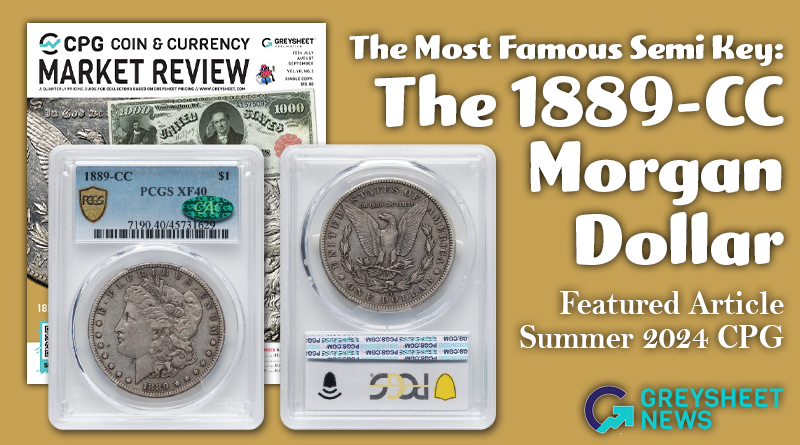
The 1889-CC is the second scarcest business strike in the series.
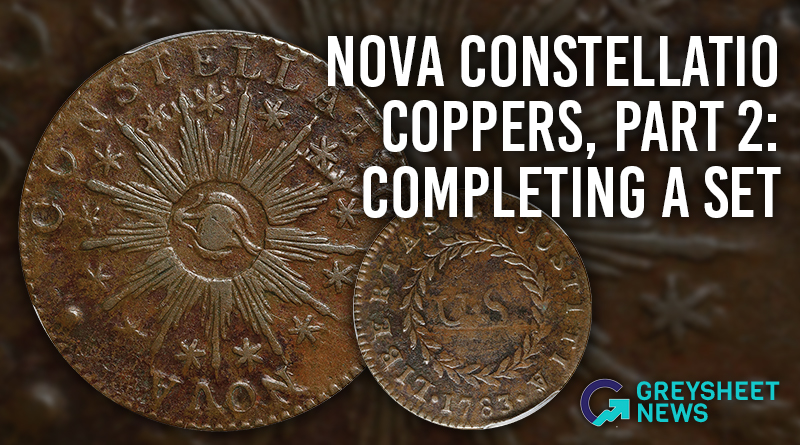
Just six coins are required for a set of true Nova Constellatio Coppers, and the coins selected need not be very expensive.


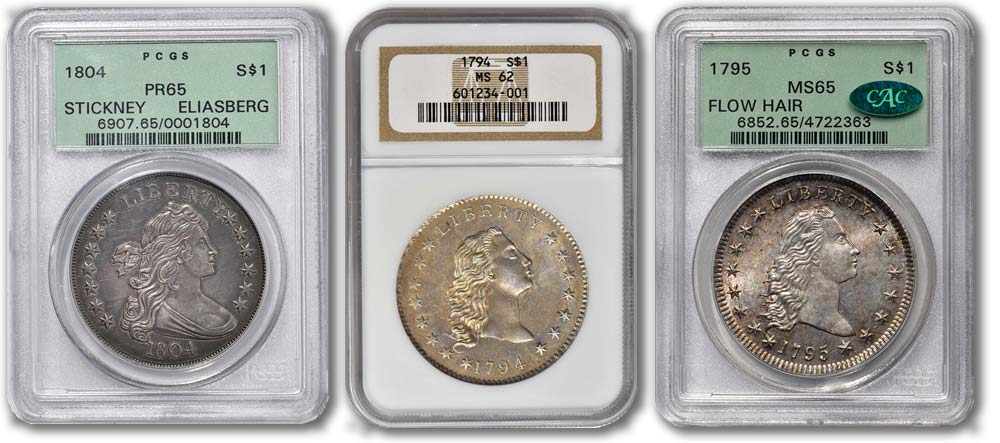






Please sign in or register to leave a comment.
Your identity will be restricted to first name/last initial, or a user ID you create.
Comment
Comments